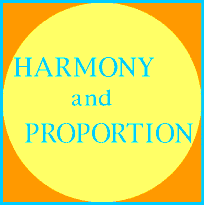These pages attempt to provide as simple as possible an introduction to, and explanation of, the principles governing harmony and proportion in space. Proportion within a geometrical figure, a musical scale , or indeed a mathematical sequence, can be said to be
"an harmonious relationship between the parts, with and within the whole".
In Chapter V of Book IX of his Ten Books Of Architecture, completed in 1452, Leon Batista Alberti begins to define the natural beauty of form which takes a mean between two extremes;
I will make use of an Example to illustrate my Meaning. Some admire a Woman for being extremely slender and fine shaped; the young Gentleman in "Terence" prefered a Girl that was plump and fleshy: You perhaps are for a Medium between these two Extremes, and would neither have her so thin as to seem wasted with Sickness, nor so strong and robust as if she were a Ploughman in Disguise, and were fit for Boxing: In short, you would have her such a Beauty as might be formed by taking from the first what the second might spare
He then goes on to propose that beauty is a consent and agreement, where the constituent parts are congruous with what the "principal Law of Nature requires".
"The Ancients....did in their Works propose to themselves chiefly the Imitation of Nature, as the greatest Artist at all Manner of Compositions."
For Alberti, "Law of Nature" is no imprecise term; in fact he goes on to develop a line of enquiry which is designed to illuminate just how such a "Law" operates in our world of shapes and forms and figures:
"We are now to treat of the Figure:
By Figure I understand a certain mutual Correspondence of those several Lines, by which the Proportions are measured, whereof one is the Length, the other is the Breadth, and the other is Height.
"The Rule of these Proportions is best gathered from those Things in which we find Nature herself to be most compleat and admirable; and indeed I am every day more and more convinced of the Truth of Pythagoras's Saying, that Nature is sure to act consistently, and with a constant Analogy in all her Operations:
"From whence I conclude that the same Numbers, by means of which the Agreement of Sounds affects our Ears with Delight, are the very same which please our Eyes and Mind. We shall therefore borrow all our Rules for the Finishing our Proportions, from the Musicians, who are the greatest Masters of this Sort of Numbers, and from those Things wherein Nature shows herself most excellent and compleat."
By linking proportion with underlying harmonious causes, Alberti was refering back to a long tradition of philosophical thought, one which, in the West at least, began with Plato and Pythagoras...
